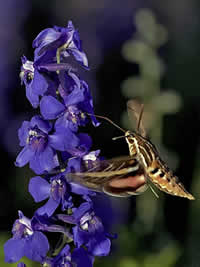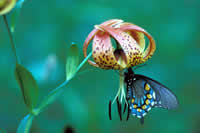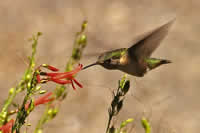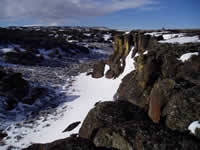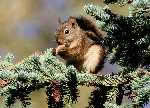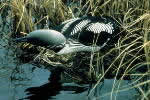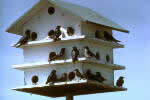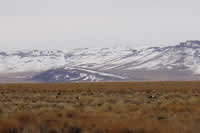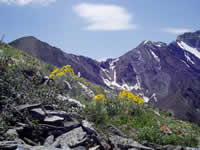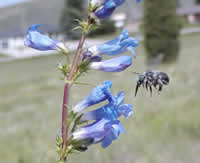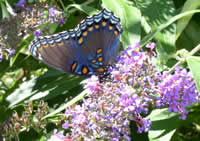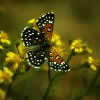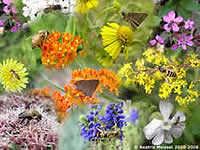USDA Forest Service Celebrating Wildflowers
|
|
|
Landscaping for WildlifeTom Patrick, President, Windstar Wildlife Institute “If nothing moves in your landscape but a lawnmower, it’s time to think of designing a natural yard.” Do you enjoy observing nature? Hearing the song of a chickadee, watching hummingbirds fill up on nectar from trumpet vines, listening to the chattering of squirrels, seeing the beauty and grace of a monarch butterfly perched on milkweed, experiencing the antics of a mockingbird, the cooing of mourning doves, the swiftness of a cottontail, and the brilliance of a cardinal or Baltimore oriole.  If you enjoy any of the activities mentioned above, you will probably want to attract more wildlife to your property. The term “wildlife” means different things to different people. To a livestock producer, it may mean coyotes. To someone who feeds birds, it may mean cardinals, nuthatches, and hummingbirds. To a birder, it may mean rare species. To a gardener, it may mean butterflies. To a wildlife biologist, the term wildlife means all living organisms out of the direct control of humans. Dr. Thomas Barnes, extension wildlife specialist, University of Kentucky, suggests that the definition should also include the habitat of the species. He says that it is impossible to understand the ecology of a species without having a thorough knowledge of an animal’s diet and how this differs during the year, plus how the species relates to its habitat (predators, vegetation, soil, competitors, etc.). Wildlife do not just randomly appear in a given area. It is there because of favorable habitat. To attract more wildlife, you need to apply specific wildlife management practices. To reach your wildlife management goals, you must manipulate the habitat, the animal population, or manage the people (landowners). Essential Elements of Wildlife HabitatThere are four essential elements needed for survival in a wildlife habitat:
If you keep these needs in mind while creating your wildlife habitat plan, your chances for success are excellent.
Photos by US Fish & Wildlife Service. Food requirements vary for every species. It changes as they age, and from one season to another. For some species, the berries in your garden are ideal. For others, it’s the nuts and acorns, grasses, grain or seeds, or nectars in flowers. Water is as important as food and is critical to survival. Adding a pond or bird bath will produce results in a hurry. Perhaps letting your pond overflow will produce wetlands. Cover is important for weather protection as well as protection from predators. It’s also important for nesting and resting. Cover can be provided by shrubs, grasses, trees (including dead trees), rock and brush piles, nesting boxes, and abandoned buildings. Space is needed for wildlife to raise their young. Most species establish territory and defend it. For example, bluebird nesting houses must be 300 feet apart or the bluebirds will fight each other. Wood ducks and purple martins do not defend territories. Loons prefer 100 acres of lake or wetlands, and ruffed grouse need 10 acres. Basic Concepts of a HabitatBefore fully evaluating a wildlife habitat, some basic concepts about habitat and relationship of habitat to different wildlife species needs to be understood! A term that you will often hear in reference to wildlife habitat is niche. This refers to the concept that each individual species in a community has its own role within that community. For instance, it is the occupation of woodpeckers to eat insects under tree bark and to excavate holes in tree trunks, while beavers can be expected to cut down trees and create dams. These are examples of species that are fairly specialized.
Other creatures could be called generalists, and they tend to be in competition with one another. For example, raccoons, foxes, and other medium-size omnivores all seek the same fruits and small mammals for food, but the variety of their food sources lets them compete successfully. Each species performs a specific role in the ecosystem that directly benefits other living things, including people. A good example is that squirrels help forests continue to grow. Squirrels bury acorns for food, but fail to dig up all of them, so acorns sprout and produce new oak trees. 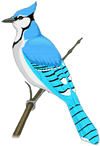 Other birds and animals scatter seeds throughout the landscape. Blue jays, for example, are especially important in the long-distance dispersal of acorns and beechnuts. They carry them to distant locations and bury the nuts in soft earth or under leaves. A Virginia study showed that 50 blue jays transported 150,000 acorns in one month. Some of the acorns were retrieved by the jays and eaten later in the year, but many were left to regenerate the forest. Within a forest ecosystem, plants grow in different vertical layers. This is important because some wildlife species may use the ground layer herbaceous plants) for food, but they also need the tallest layer (tree canopy) for shelter. The middle layer is composed of shrubs. If you follow nature’s lead by planting in layers, this will allow for the different feeding and nesting habits of many species. While it is not necessary to give up entirely on having a lawn, limiting its size will not only benefit wildlife, it will also save you time and money. Mowing, chemical treatments, weeding, and watering are all costly—both in terms of what you pay for them and the number of hours that you spend doing them. The place where two or more different plant communities or successional stages meet (such as where a forest meets an open area) is called edge. Sometimes there is an abrupt change, or distinct edge, between plant communities. Other times there is no sharp or distinct difference, but only a gradual change from one plant community to another. The latter attracts the most wildlife. Jonathan Kays, Maryland regional extension specialist for natural resources, says that if there is one single rule to follow in attracting wildlife, it is to make your landscape as diverse as possible with many different plant species. Then, your habitat is less vulnerable to insect damage or diseases that can wipe out single species. In ecosystems, diversity means stability and ability to withstand change. You will find that wildlife thrives when you landscape using a wide variety of plants. Some plants will be evergreen or form thickets for cover, while others will be valuable because of the flowers and fruits that they bear. Become aware of the needs of the wildlife species in your area. Fancy double-petaled, ruffled blossoms are lovely in the garden, but butterflies can’t access the nectar in them, so you should also provide the flatter, more open blooms that butterflies prefer.
Always be careful not to plant invasive exotic species, such as multiflora rose and Japanese honeysuckle, which can overwhelm native plants and be nearly impossible to eradicate.
Wildlife needs extend through all four seasons of the year, so be sure to plant a variety of trees, shrubs, and flowers that bloom or bear fruit at different times of the year. For example, crabapple trees provide fruit in fall and winter. Cherry trees produce fruit in summer. Hickory trees produce nuts in the fall. Food, water, and cover need to be arranged close together to produce optimum results. This cuts down on mortality from predators when wildlife species move from one habitat element to another. Connecting elements with a corridor of good cover is important.
Thoughtful landscaping can help to maintain biodiversity. By offering many kinds of native plants, you are ensuring that a wide range of wildlife can thrive. WindStar Wildlife Institute is a 501(c)(3) national, non-profit, conservation organization. Its mission focuses on effectively teaching and communicating wildlife habitat improvement methods, including promoting the use of native plants. The institute holds seminars throughout the country and certifies wildlife habitats and also individuals as “wildlife habitat naturalists.” The institute is located at 10072 Vista Ct., Myersville,MD 21773. Phone: (301) 293-3351. Web: windstar.org. E-mail: wildlife@windstar.org. |
||||
| NOTE: PDF format links require the Adobe Acrobat Reader to view. | ||||
| top | Disclaimers | FOIA | Privacy Policy | Quality of Information | Photo Credits & Use |
Location: http://www.fs.fed.us/wildflowers/nativegardening/landscapingforwildlife.shtml
Last modified: Tuesday, 24-Jun-2008 21:54:51 EDT
